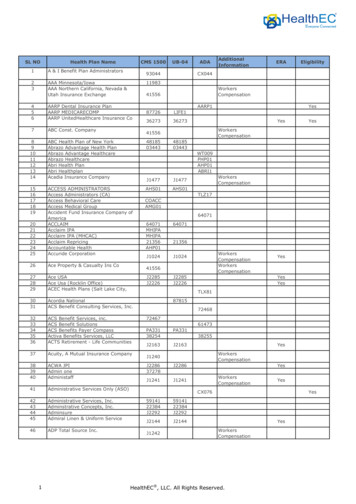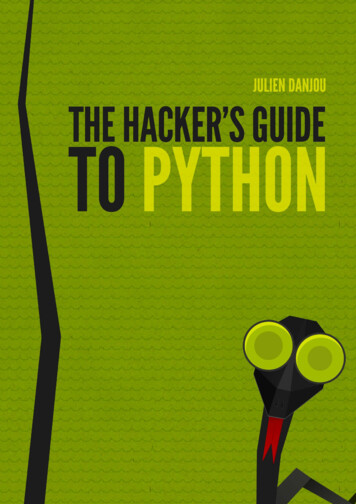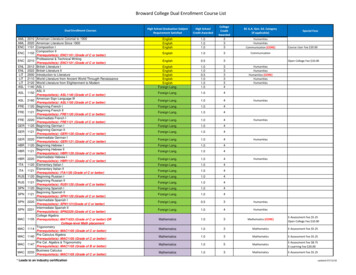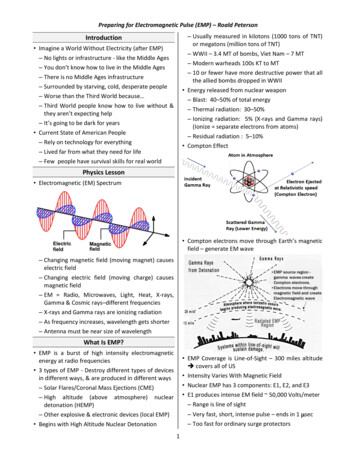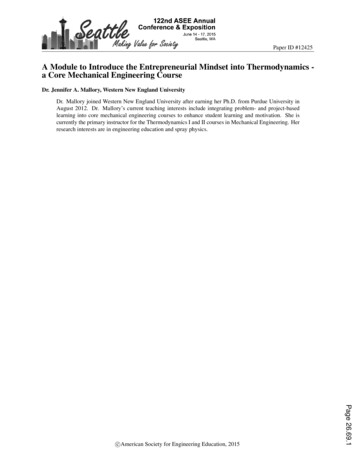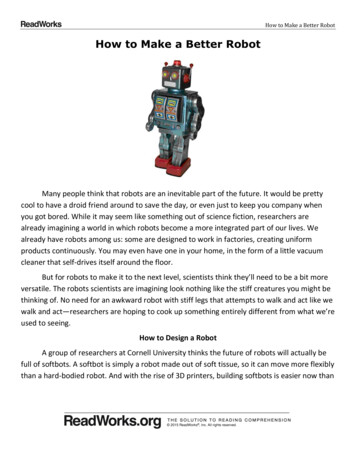
Transcription
How to Make a Better RobotHow to Make a Better RobotMany people think that robots are an inevitable part of the future. It would be prettycool to have a droid friend around to save the day, or even just to keep you company whenyou got bored. While it may seem like something out of science fiction, researchers arealready imagining a world in which robots become a more integrated part of our lives. Wealready have robots among us: some are designed to work in factories, creating uniformproducts continuously. You may even have one in your home, in the form of a little vacuumcleaner that self-drives itself around the floor.But for robots to make it to the next level, scientists think they’ll need to be a bit moreversatile. The robots scientists are imagining look nothing like the stiff creatures you might bethinking of. No need for an awkward robot with stiff legs that attempts to walk and act like wewalk and act—researchers are hoping to cook up something entirely different from what we’reused to seeing.How to Design a RobotA group of researchers at Cornell University thinks the future of robots will actually befull of softbots. A softbot is simply a robot made out of soft tissue, so it can move more flexiblythan a hard-bodied robot. And with the rise of 3D printers, building softbots is easier now than 2015 ReadWorks , Inc. All rights reserved.
How to Make a Better Robotever before. The question that remains is: what will these robots look like? How will theymove? How will they carry things, or navigate small quarters?These are precisely the questions these scientists are trying to answer. It’s easy enoughto build a robot that mimics a human. We already know what we look like and how we move.But how do we know this is the best way for robots to move? To put it simply, we don’t.The researchers are trying to figure out all the different ways robots could move.They’re basically in the middle of a very long brainstorming session. Once they realize what theoptions are, they can figure out which motions are best suited to which actions, and create afinal model that will perform the best in all scenarios.In order to do this, they’ve built a computer program that simulates the growth andmovement of several kinds of softbots. They can use animated tissue, muscle, and bone tobuild a large number of different kinds of softbots. Then the computer program runs therobots through tests, checking out things like balance, coordination, or noisiness. In oneexample, they’re looking for speed, so the fastest robots get to stick around, while the slowestrobots get cut.The PossibilitiesWe’re going to take a look at all of the different options for how a robot can move fromone point to another—this is the speed test. Scientists run a computer program several times,and each time, the robots are a little bit different. Sometimes, they focus on giving the robotslegs—either two legs like humans have, or four, like many animals have. And sometimes theysee if they can make a mover without legs.The fastest robot they created has legs and runs in a bounding motion—the front legsmove together and the back legs bound forward, similar to how a cheetah moves. Anotherrobot was made to have long legs that were mostly made of bone. These legs became long andskinny, so it wasn’t surprising when the robot started to gallop like a horse.Other times, they try to make robots that can move in non-traditional ways. In oneinstance, they created a funny sort of robot that doesn’t have very much structure, just a bigblob of muscle. This robot moves by inching its body forward, pulling its body in tight, andthen releasing it to go long, much like an inch worm. It’s not a very fast robot, but it does have 2015 ReadWorks , Inc. All rights reserved.
How to Make a Better Robotan advantage, the researchers realized. If they picked this robot up and dropped it randomlysomewhere else, the robot would just keep on moving as if nothing had happened. Theresearchers realized this trade-off—the bot may not be very fast, but it certainly is durable.They even make some robots that seem almost silly from the outset. For example, some oftheir creations are designed to have no legs at all, but they still had to figure out a way tomove them forward. One of the designs that resulted from this is a big robot that, instead oflegs, has two large wings, and it flaps them back and forth to move. The design is almost like agorilla relying primarily on its arms to move, but it’s a bit bulkier. Another robot that came outof this is a little guy who looks like an open jack-in-the-box. The bottom of the body is boxshaped, but at the top, out pops two little arms. This robot moves by flailing its arms back andforth, which make the little guy slowly progress forward. It may seem silly, but an advantagethis robot has is that it could easily hold things in its hands, or its empty lower-box while stillmoving forward.Putting Ideas into ActionNow that the researchers have a number of ideas in mind, they can start performingother tests to see which robots perform better at tasks besides moving themselves along.Maybe they’ll have to measure how much energy the robot requires to function for a longperiod of time, or how much space it takes up. All three of these aspects will play into thefuture success of the robot, so it’s important to consider them all separately. Even ifsomething ends up looking silly in a trial, the underlying reason behind its success may stillwarrant a characteristic to be considered for the final design.For example, perhaps one of the softbot’s tasks will be to take out the garbage(wouldn’t that be nice?). For that, you’d want a robot that could carry things and one not likelyto fall. You’d also want a robot that was pretty quick, but you’d have to balance your desire forspeed with steadiness. If the bot drops its load half the time, on average, it won’t be so fast.Therefore, you have to incorporate a number of skills.When making the robot, the researchers will have to look through all of the ideasthey’ve created in their computer program, and pick and choose which characteristics willwork best together to create a robot that can easily take out the garbage. They’ll have to 2015 ReadWorks , Inc. All rights reserved.
How to Make a Better Robotbalance their desire for speed with a steady hand, and the ability to carry heavy loads with adesire to make the robot light enough for a human to move around if the robot’s turned off.A good way to think about it may be through imagining yourself picking out yourfavorite clothes to wear. One day you may be torn between wearing the T-shirt that’s extrasoft, so it’s really comfortable to wear, and another shirt that’s your favorite color. Having topick between these options will probably convince you to eventually find a new shirt that isboth the fabric that you like and the color that you like. Now this new shirt will probably beyour favorite, since it has all of the positive qualities you love.The Final ProductGoing back to designing our robot that will help take out the trash, it might be nice forthe robot to be fast, but is that really the most important thing? It might be better to have aslower robot take out the trash. That way, there’s less of a chance the robot will fall and dropthe trash (making it necessary for you to clean it up). In that case, let’s go back to the robotthat moves sort of like an inchworm. That robot had a lot of body mass on the ground, so itwas tough to tip over—think about tipping over a butter dish versus a candlestick.Maybe when the robot has taken the trash out, you will want it to be fast. The bestthing to do then is allow it to separate its front section into two legs, and its back section intotwo legs. Then it can move in that cheetah-like style, going faster. Perhaps the design ofincorporating both ideas into one will result in a final product that isn’t completely an inchwormer, and isn’t completely a cheetah either. The robot’s body is a little too sleek to be aworm and a little too lumpy to be a cheetah. But the beauty of the final design is that therobot is more versatile, and can do everything you need it to do.Hopefully, these types of robots will enter our lives soon. The Cornell researchers willjust have to keep brainstorming different types of robot bodies, so we can always have thebest selection of traits to pick from. 2015 ReadWorks , Inc. All rights reserved.
ReadWorks.orgHow to Make a Better RobotName:Date:How to Make a Better RobotBy ReadWorksReadWorks.orgTHE SOLUTION TO READING COMPREHENSION 2016 ReadWorks , Inc. All rights reserved.
ReadWorks.orgReadWorks.orgHow to Make a Better RobotTHE SOLUTION TO READING COMPREHENSION 2016 ReadWorks , Inc. All rights reserved.
ReadWorks.orgReadWorks.orgHow to Make a Better RobotTHE SOLUTION TO READING COMPREHENSION 2016 ReadWorks , Inc. All rights reserved.
of this is a little guy who looks like an open jack-in-the-box. The bottom of the body is box-shaped, but at the top, out pops two little arms. This robot moves by flailing its arms back and forth, which make the little guy slo
